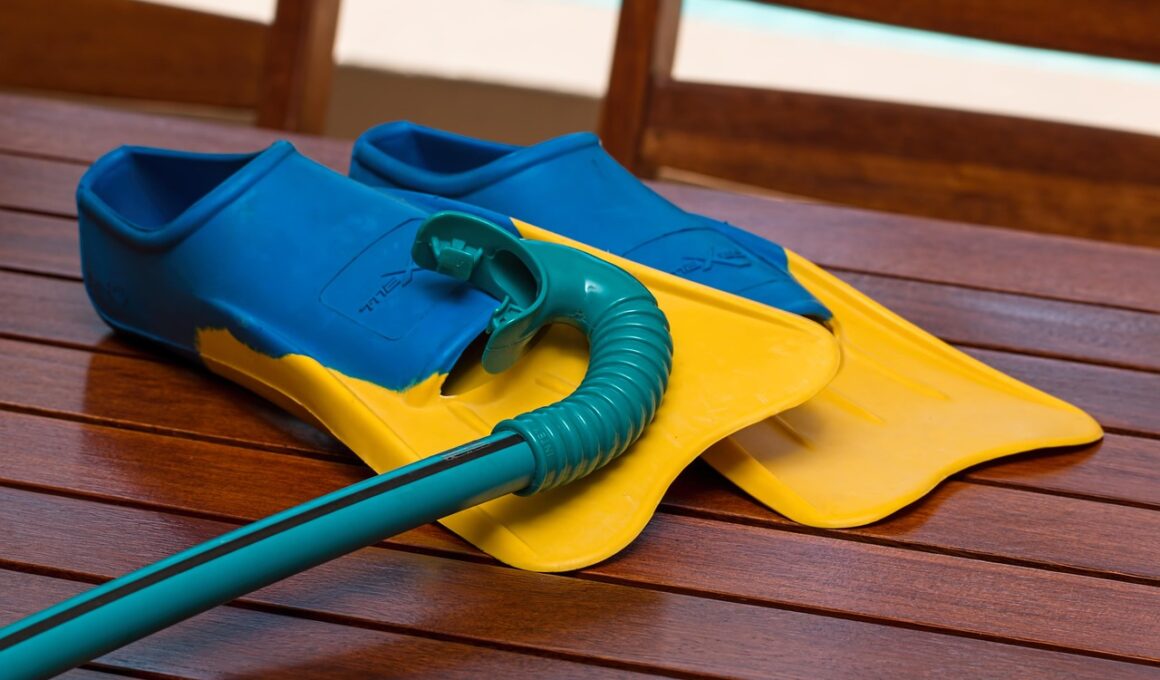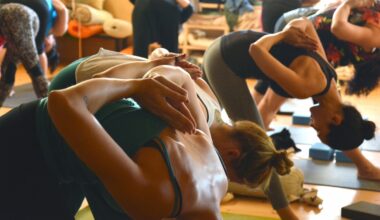Clothing and Equipment Choices for Maximum Performance
To excel in swimming competitions, athletes must consider their clothing and equipment. The appropriate swimsuit can greatly impact a swimmer’s speed and comfort in the water. It is essential to choose a suit that fits tightly without being overly restrictive, allowing for optimal flexibility. Common choices include high-tech materials designed for speed, such as polyesters and nylons. Look for suits that reduce drag, as less resistance will lead to faster times. It’s also important to consider the type of competition. For example, racing suits are specifically designed for open water or pool events. Swimmers should experiment with their gear during practice to ensure comfort. Additionally, the choice of cap and goggles is crucial to maintaining focus and reducing distractions during the race. Caps keep hair out of the face, while goggles protect eyes and improve visibility. Swimmers should ensure their goggles fit well to prevent leaks. Lastly, wearing appropriate training suits for practice can help swimmers save their racing gear for competition days. Trying different brands can offer varying levels of comfort and fit, so it’s worth testing multiple options before making a final decision.
Another crucial element of swim meet preparation is understanding the importance of accessories. In addition to swimsuits, other gear like swim fins, paddles, and kickboards can enhance training sessions. Swim fins help improve kick strength, providing resistance that builds leg power. Training paddles help increase stroke strength and shoulder stability, contributing to overall race performance. Kickboards are useful tools for refining kick strokes and body position, allowing swimmers to focus on technique. These tools can also be instrumental when preparing for competitions, as they assist in specific drills that improve speed and efficiency. Incorporating these items into swim practices can lead to significant improvements in performance. Furthermore, swimmers may want to invest in a waterproof watch or a flip-turn clock that measures lap times effectively. Monitoring performance during training can aid in identifying areas for improvement before a meet. Staying organized with gear is another vital component of preparation. Designate a bag for all swim equipment, including warm-up and racing suits, caps, goggles, and accessories. This minimizes last-minute scrambles or the possibility of forgetting essential items on race day. Having everything ready can alleviate some pre-meet anxiety, ensuring a focused performance in the water.
The Role of Footwear in Swimming
While swimming is predominantly water-based, the choice of footwear is significant during meets, particularly when moving on deck. Swimmers should wear lightweight, non-slip shoes or flip-flops that provide comfort and support as they move from warm-up areas to the competition pool. Proper footwear protects against slips and falls, which can be dangerous, especially on wet surfaces. Avoiding heavy or cumbersome shoes is essential, as they can weigh down a swimmer’s movement. Swimmers should look for shoes designed for aquatic environments, as these can help maintain grip and stability while remaining comfortable. Some athletes prefer specialized swim shoes that can be worn for both walking around the venue and entering the water. Comfort is key when wearing shoes to prevent any distractions during warm-up and competition. Additionally, good footwear can help prepare athletes’ feet for rigorous activity, contributing to better muscle support and minimizing injury risks. Even after a grueling event, investing in high-quality shoes means athletes can recover more effectively between races. This attention to detail in swim meet preparation ensures swimmers maintain their focus and performance standards.
Apart from selecting swim gear, nutrition also plays a pivotal role in swim meet preparation. Proper nutrition supports energy levels and stamina, crucial for optimizing performance. Incorporating a well-balanced diet rich in carbohydrates, proteins, and healthy fats will help fuel the body efficiently for both training and competition. Swimmers should plan their meals beforehand, focusing on nutrition that will sustain energy throughout the event. Foods such as whole grain pasta, lean protein, and plenty of fruits and vegetables should be staples. Hydration is equally critical. Swimmers need to ensure they are adequately hydrated in the days leading up to the competition. Consuming sufficient water before, during, and after swimming can prevent fatigue and muscle cramps during races. Moreover, consider timing meals strategically, consuming smaller meals or snacks two to three hours before events to avoid discomfort. Pay attention to how the body responds to specific foods as some might cause stomach issues on race day. Experimenting with nutrition during practice can help identify what works best in terms of performance. Proper eating habits enable athletes to bring their best selves to race day.
Mental Preparation Techniques for Swimmers
Mental preparation is as crucial as physical readiness in swimming. Athletes often face intense pressure during competitions, making mental toughness imperative. Techniques such as visualization and mindfulness can greatly enhance a swimmer’s performance. Visualization involves imagining oneself succeeding during races, focusing on technique and positive outcomes. This forms a mental blueprint that can bolster confidence and reduce anxiety when competing. Mindfulness exercises help athletes stay present, minimizing distractions and stresses that may arise before or during a race. Swimmers might also find it helpful to establish routines that center them, such as specific warm-up exercises or breathing techniques. These routines can create a sense of familiarity and comfort, which eases pre-race nerves. Journaling about experiences during practice or competition can also help swimmers process their emotions and thoughts. Reflecting on past performances enables athletes to learn from experiences, fostering self-improvement and resilience. Engaging with a sports psychologist or coach can provide additional strategies for mental preparation. Such approaches may not only improve performance during meets but can also enhance overall enjoyment of the sport.
In summary, proper clothing and equipment choices significantly impact swim meet performance. Every detail matters, from the swimsuit’s fit to the choice of accessories. Prioritizing comfort and functionality ensures that swimmers compete at their best. Additionally, mental preparation complements physical readiness. Swimmers should consider both their physical gear and mental strategies as they prepare for an upcoming meet. Proper nutrition and hydration cannot be overlooked, as they fuel the body during strenuous events. Swimmers who take the time to prepare holistically are more likely to find success and satisfaction in their competitions. A well-organized approach minimizes distractions while maximizing focus and performance. The right mindset can make a world of difference when stepping onto the block. Swimmers are advised to engage in both practice and competition regularly to build confidence. Familiarity with routines, cheers, and conditions can also aid swimmers in acclimatizing to meet environments. Overall, strategic preparation in clothing, equipment, nutrition, and mental state creates a comprehensive approach for athletes looking to perform their best when it matters the most.
The Impact of Swim Meets on Performance
Swim meets often serve as a culmination of countless hours of practice and dedication. Participating in competitions allows athletes to measure their growth and progress over time. For many swimmers, each event provides an opportunity to set new personal bests or gain experience against varying levels of competition. The stakes can be high during swim meets, which helps swimmers learn how to handle pressure and cultivate composure. Adapting preparation, both mentally and materially, allows athletes to refine their skills in a practical setting. Swimmers also gain insights into competitive strategies, learning from opponents and coaches about race tactics. Engaging with fellow competitors fosters camaraderie, motivating swimmers to push their boundaries. Successful swim meets can provide invaluable lessons and boosts in confidence that transcend into other aspects of life. For instance, learning to cope with challenges during competition can prepare athletes for future endeavors. As the swimming community continues to evolve, athletes must focus on adapting to changing technologies and methods while embracing the sport’s rich traditions. Swim meets truly represent the essence of competitive spirit and personal achievement, ultimately shaping athletes both in and out of the pool.
Finally, as athletes conclude their meets, the necessity of recovery must be emphasized. Post-event recovery allows swimmers to recuperate physically and mentally from the challenges faced during competition. Emphasizing proper cool-down techniques can greatly benefit an athlete’s recovery process while reducing the risk of injuries. Stretching, hydration, and nutrient-rich post-race snacks will help replenish energy stores and repair muscle tissues. Many swimmers utilize techniques like foam rolling or massages to alleviate tight muscles after intense races. This extra attention to recovery ensures players are prepared for upcoming events and training sessions. Mental recovery is equally vital; taking time to reflect can foster learning and self-awareness. Swimmers can assess their performance, focusing on accomplishments and identifying areas for improvement. Engaging in relaxation activities such as yoga or meditation can also provide substantial benefits for mental clarity. Compiling competition results and discussing outcomes with coaches can inspire athletes to set new goals. The journey does not end at the meet; it continues as individuals enhance their skills and prepare for future challenges. Overall, a comprehensive approach to recovery positions athletes for long-term success in their swimming careers.


